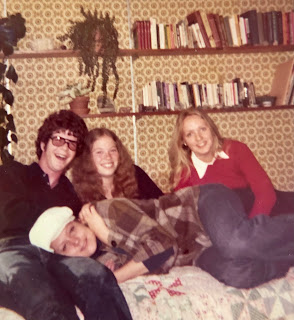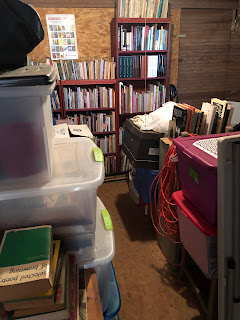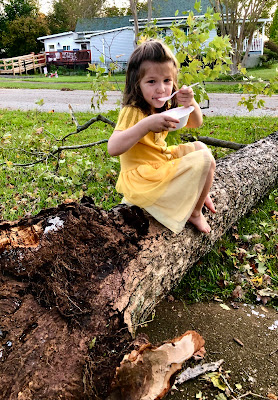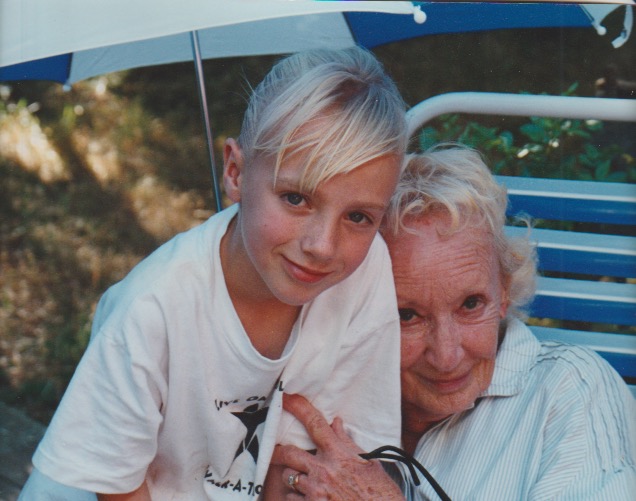THE LAST SUPPER PARTY: OF HURRICANES, HAVILAND CHINA, AND THE SWEDISH ART OF DEATH-CLEANING
In college, the four of us were called ‘The Kids.’ We were the proteges of W., a graduate student who was only a few years older than us but who, in our cow-town California eyes, was the epitome of knowledge and NY-style sophistication. The only male student in this group of undergraduate drama majors, N. D., was a buoyant and lovable young man who would eventually move cities a great deal, explore his sexuality, and finally settle down in a conventional marriage, raising two children and running a music store in the Pacific Northwest. I lost touch with him for decades, but reconnected when he reached out to me on Facebook. He seemed to have retained his sense of humor, but with the passing of his wife from cancer he had lost some of his buoyancy, and he expressed frustration with the slow spread of progressive thinking in America and the ravages wrought by runaway capitalism around the globe.
One winter’s day not long ago, I went online to read his latest post and discovered that it was not N. D. himself posting, but a close relative, who announced, with brutal brevity, that N. D. had ‘breathed his last breath’ a certain day earlier that week. I was so shocked I didn’t know how to react. I scoured the internet for a larger explanation: had my old friend died of Covid? A heart condition? Had he taken his own life? No explanation could be found, and I was left to wonder how a man could die who had been renewing old ties just weeks before, and who would be forever preserved in my mind as a goofy nineteen-year-old, sensitive and creative, bursting with life.
 |
| The Kids on a foray to San Francisco, author in red |
This was the first step taken in my slow realization that I am growing old. Friends and family members who are my age or younger are reaching the end of their lives: accidentally, by means of disease, through the despairing mechanism of suicide, or – and this is critically important – of natural causes. I have attained THAT age when one looks around and understands that from here on out, every day is a gift, and that one ‘must work the works of Him that sent me, while it is day: the night cometh, when no man can work.’ (John 9:4)
This realization opened up a wider lens for me which I have come to call Mortality Reality. In practice, it’s less morbid than it sounds; rather than focusing on death, it means living your life as if you know you have a finite number of days on earth and must put those days to good use. Not long ago, I gifted my husband and myself with copies of the manual: "I'M DEAD. NOW WHAT?" and we have been filling our respective pages with financial and medical information, identifying heirlooms we'd like our daughter to keep, and specifying last wishes. Knowing that members of my own family as well as my husband's have passed out of this world leaving behind massive accumulations of stuff for the living to dispose of, I am resolved not to pass that burden on to my child.
 |
| The basement. |
The problem is that when we moved into this house fifteen years ago, we were downsizing, which meant that belongings we had carted cross-country back in '95 and lugged to three different homes had to be left in their boxes in the attic of our current house or in the damp walk-out basement. By now, the items in the basement have almost surely been ruined, while just contemplating the cartons packed in our spider-haunted closets and the large but largely inaccessible attic gives me severe arachnophobia and suriphobia (think spiders and mice).
Seeking guidance as well as inspiration, I turned to a popular book by the Nordic artist and writer, Margareta Magnusson, titled "The Gentle Art of Swedish Death-Cleaning" (or 'dostadning,' in Swedish). It turned out to be a small manual with a life-changing message: free yourself from the baggage you have acquired in exchange for living your remaining years unencumbered and sparing your descendants the onerous job of clearing out your hoard once you've passed on.
 |
| Artist's rendering of a powerful Viking woman's burial with horse and dog |
I like the comparison she draws to Viking chieftains who were buried in the 9th century A.D. with their most prized possessions: shields, spears, metal cuffs and jewelry, even an entire horse or two. 'You can't take it with you' wasn't a Viking adage, apparently, because they believed they would need certain tools, weapons and ornaments to live happily in the next world, and they took these to the grave. In modern times, however, and in our expendably consumerist age, our belongings are too numerous to follow us into the afterlife.
Does that mean we have to purge our homes and spaces of everything that lacks utility? No. But we need to take a clear-eyed look at what's occupying square footage and decide what we can live without or what we no longer have room for in our lives. Once we've identified these things, Magnusson suggests putting these items in categories to simplify our "dostadning." These categories are: Things to Throw Away, Things to Donate or Give Away, Things to Sell, and Things to Keep. She also suggests starting the process by tackling the easiest things to shed (clothing: it will be clear to you what no longer fits, is out of style or has become shabby, and removing these items will free up a lot of space in closets) and working your way towards the most difficult (photographs; because you will spend a lot of time poring over them, reliving memories).
If you have children, you will also want to begin asking them about possessions of yours they would like to have when you are gone. I remember that when my dear mother was aging inexorably, we four sisters implored her to visit a lawyer and have a will drawn up. (See my previous post from Feb. 14 2024, "The Tree Shall Be Known By Its Fruit," for a fuller story of my mother, MJR). Or, barring that, that she make a list of which items she was leaving to which daughter. My mother’s characteristically eccentric response was to laugh and refuse, saying “I’d rather have you all fight over me!” That is exactly what we did when she developed dementia and could not care for herself, leaving the public guardian and the courts in her home county to assign care of her to me and my family in North Carolina, while my sisters got busy smuggling out of her home whatever was transportable. After that, the remaining contents of the house were hauled to a special dump by a crew of toxic-environment specialists dressed in Haz-Mat suits.
That is probably why I am so determined not to repeat my mother’s abdication of her end-of-life responsibilities. Recently, my husband and I set up a FaceTime conference with our daughter, who advised us about healthcare power-of-attorney, medical directives and executors. She also offered to schedule us with a local lawyer in order to write up and witness our individual wills.
 |
| Eva Graff Rivers' wedding china, Clover Leaf by Haviland, early 20th c. |
With that ball rolling, I was also able to share with L. B. that I had identified and valued certain sets of heirloom china and silverware that I had hoped to pass on to her and which she has agreed to take, as well as a few significant furniture pieces in our home which she may disperse as she sees fit. Obviously, she can get rid of anything left behind when we have both moved on, but it was helpful for me to see what she values and what is less important in her eyes. It helps me commence death-cleaning with a lighter heart!
If I needed a refresher course in living more simply, it was provided by the recent hurricane that smashed through our community in upstate South Carolina. Striking in the pre-dawn hours of Sept. 27, Hurricane Helene ravaged our neighborhood, knocking power poles and lines to the ground and pulling down large trees like the one that fell in our front yard, blocking our street.
 |
| Helene left her mark on our town |
For four days we had no electricity, meaning no refrigeration, no washing machine, no water heater for showers or baths, and no air conditioning. With the internet down, we also lost connectivity.
We’ve been through this before: in the Loma Prieta earthquake of 1989, when the contents of our humble home in San Francisco were shaken to bits by the 6.9 tremblor, and again in 1996 when, having relocated the previous year to Wake Forest, North Carolina, Hurricane Fran sent a sweetgum tree crashing through our roof and blocked roads for miles around. In each case, as with Helene, life boiled down to meeting elemental needs. Everything else fell by the wayside.
 |
| Loma Prieta earthquake, San Francisco 10-17-1989 |
In such a world there is no entertainment except what we devise from our own imaginations, no music except that which we produce, and, unless you are the parent of young children, no distractions from the pressing needs of the moment. On the other hand, there IS communication, but it is person-to-person, not removed by the electronic systems of messaging and posting and commenting. I wouldn’t want to live in such a world permanently (mainly because, since my first week living through a torrid Southern summer, I became a fervent devotee to air-conditioning) but whenever I have dwelled there for a few days thanks to some upending natural disaster, I am always more aware of how these hardships focus me on aspects of life that possess real value. Among these are: a solid roof over one’s head, a partner to share the load, and kinships in the community that promote cooperative effort and connection.
 |
| FK cooked on a Coleman stove for a week after Hurricane Fran, 1996 |
In the case of Helene, we were lucky to have next-door neighbors who have felt like kin to us from the day they moved in last May. Elizabeth is my daughter’s age and is the mother of four bright, funny and active children under the age of eleven whom she homeschools. When our families have a surfeit of anything, we share it, and in that way we have crossed the street to exchange muscadine grapes, fresh tomatoes, zinnias grown from seed, pot pies (made by E. and delicious), gingerbread men at Christmas, fig cakes, and most importantly, information. In the aftermath of Helene, we were all desperate to know when the power poles might be put back in place and electricity restored, but Duke Power couldn’t tell us anything, and with the internet down, we could only guess at how widely the storm had affected communities around us. E. and her husband P., however, are active on several fruitful grapevines, and in this way we learned on Day 4 that power had been restored to the Baptist Church on Charleston Street on the west side of our town, meaning we would likely be spared a fifth night in the dark; that the Ingles Market had opened in the county seat but they were only allowing twenty people inside to shop at one time; and that two more storms with the potential to be damaging were brewing in the Caribbean. Lord help! Helene roared through upstate SC on its
way to the NC mountains
When local cell towers were repaired, at last, and we were able to scroll through the limited news provided by our phone apps, I viewed horrifying videos of homes, businesses, livestock, and even people being swept into floodwaters by Blue Ridge rivers that had burst their banks and eliminated towns in the mountains of western NC. It hurt my heart to see these. I tried to imagine how I would react if I knew my house was about to be carried away to certain destruction: what would I try to save? My husband and I would rescue our two dogs, of course. I wouldn’t be able to save my grandmother’s wedding china, but I could possibly snatch up my father’s violin and my daughter’s baby book before running out the door. But as for the plastic storage boxes containing hundreds of student papers and lesson plans from my years as a college English instructor? The bulky kitchenware I haven’t touched in years, the muffin pans and plastic bowls and the vintage cake carriers I once fancied as collectibles? Or how about the dozens of tablecloths and runners I accumulated over the years, but which I rarely take out of the cupboard now that our days of hosting dinner parties are at an end? I know without being told by a death-cleaning expert that these things are non-essential and should go into the Giving Away or Throwing Out pile well in advance of a natural disaster. In fact, imagining my collection of Southern fruitcake tins bobbing downstream on a flooded river would be comical, if it weren’t so instructive. I have too much stuff. I must begin to pare down, and when I do, I expect to feel a great deal more liberated than I have done for many years.
 |
| In times of crisis, 'stuff' loses its importance. Author's daughter surveyed the damage after Fran, 1996 |
Actually, I spoke too soon in saying that we no longer entertain. Upon hearing the sad news that our neighbors are moving back to Florida in order to be closer to her parents, I was determined to host their entire family for supper on a night of their choosing. E. suggested Friday, September 27, and we set the date early in the month, unable to anticipate how forcefully Helene would roar through our region in the early morning hours on the 27th, cutting us off from the world. In the aftermath, everyone was busy dealing with the damage and trying to plan for the uncertainty that such a crisis brings. But in the afternoon, I walked over to our neighbors’ house to ask E. if they might not welcome a hot meal after all. Luckily, my kitchen range is gas-powered; the stove is useless without electricity but the burners can be lit the old-fashioned way, using matches. I had a refrigerator that was rapidly warming, and food that had to be used soon if it was to be eaten at all. I was pleased that she agreed.
 |
| E. P. took the selfie of us gathered for our Hurricane Supper |
Having moved up the timing of our meal by a couple of hours in order to optimize the daylight, all eight of us gathered in our dining room around the big teak table FK and I moved cross-country, the one we picked out years ago at an antique shop in Berkeley.
We talked by the light of my mother’s kerosene lanterns, eating off vintage dinnerware and making good use of the flatware we’d brought home from Colonial Williamsburg when my daughter was only ten years old, a set we’ve since used for every special occasion. I brought out the linens we rarely use anymore and cut a few shredded flowers from the garden to grace the table. As the meal wore on, however, I realized that I had been guilty of gilding the lily. The most impressive aspect of the dinner party on that magically strange evening was not the food or the décor. It was the young faces I looked upon, glowing in the lamplight.
 |
| Miss C. P. took dessert on the fallen tree |
Night may be closing in on me, but I'm hoping to have enough time to put my world in order before leaving it. I owe that much to the generations that follow me, who will be facing a host of challenges more daunting than the ones I tackled, and with the planet at stake, infinitely more important.
###
FAQS on Hurricane Helene:
Size: Category 4 at landfall (Catastrophic), with 140 mph winds. 500 miles wide at peak of strength.
Areas affected: the 6 states severely impacted were Florida, Georgia, South Carolina, North Carolina, Virginia & Tennessee.
Landfall: Helene made landfall at 11:00 p.m. in the Big Bend area of north western Florida. It was forecast to make a direct hit on Tallahassee but swerved to the south and east at the last moment, striking the community of Perry, Florida, with 140 mph winds and a 15 foot storm surge in some beach communities.
Death toll: 250 and counting, with bodies still being recovered at this writing. Half the deaths have occurred in North Carolina, where flooding and mudslides in the mountains of Western North Carolina swept away entire communities like Chimney Rock and Bat Cave.
What It Means: Helene’s rapid intensification from a disorganized group of small storms to one devastating hurricane has been attributed by climate scientists to global warming, in particular to the high temperatures recorded in the waters of the Gulf of Mexico. Experts at the NOAA estimate the amount of rain dropped on the southeast by the hurricane totaled 40 trillion gallons.
How to Help: The North Carolina Disaster Relief Fund is accepting donations to help feed, house and clothe mountain residents and to supply them with firewood and other means of staying warm as winter closes in on Appalachia. Donate online at nc.gov/donate or mail donations to North Carolina Disaster Relief Fund, 20312 Mail Service Center, Raleigh NC 27699-0312. The Asheville Humane Society is also seeking donations to fund five pet food distribution sites they have set up in coordination with Manna Food Bank and to provide ongoing care for animals in distress. Go to www.ashevillehumane.org or call (828) 761-2001 for details.
###
Photo of Loma Prieta earthquake damage by USGS appeared in the San Luis Obispo Tribune, October 1989.
Illustration of excavated Viking burial site by Miroslaw Kuma appeared on website Life in Norway, www.lifeinnorway.net
This text is solely the property of the author. No portion may be copied, edited or reprinted without the express written permission of the author. The photos used in this post are solely the property of the author except where specifically noted and may not be copied, edited or reprinted without the express written permission of the author.
written permission of the author






Comments
Post a Comment
Thanks for dropping by!